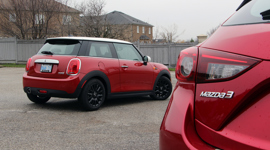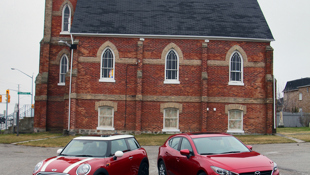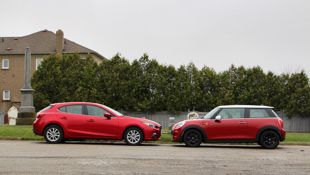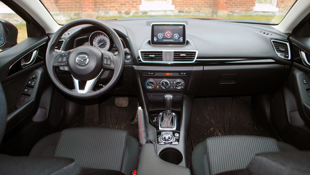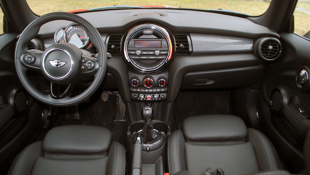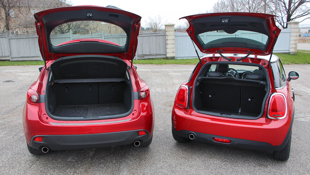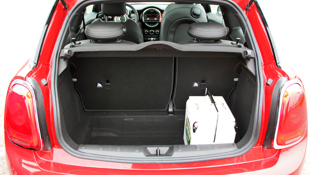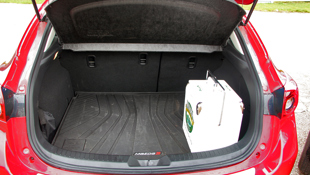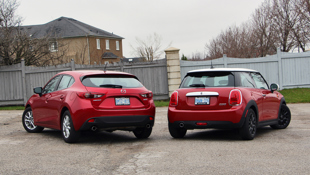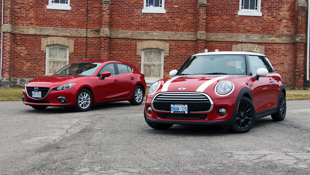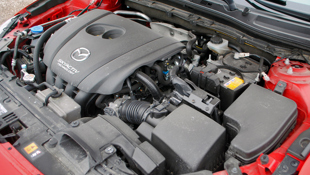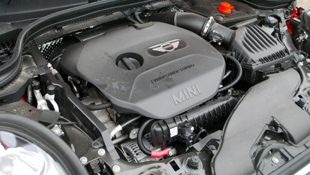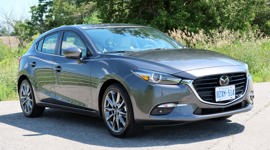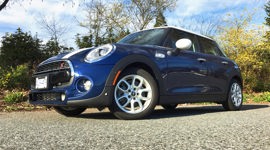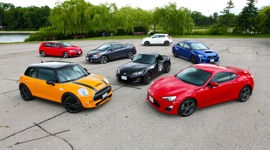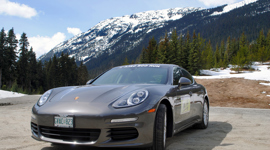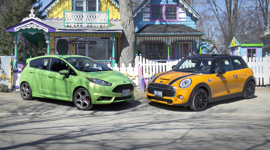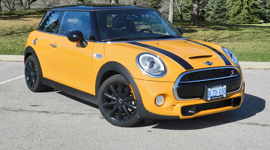Comparison Data
|
Base Price
$20,695
|
$20,900
|
|---|---|
|
A/C Tax
$100
|
$100
|
|
Destination Fee
$1,695
|
$1,655
|
|
Price as Tested
$26,280
|
$26,245
|
|
Optional Equipment
Automatic Transmission $1,200, Metallic Paint $590, Convenience Package $500, Moonroof Package $1,200, Paint Charge $300
|
Loaded Package $2,100, Metallic Paint $590, Dynamic Damper Control $500, Anthracite Roofliner $250, 16” ‘Victory Spoke’ Tires $150, White Stripes $130
|
City dwellers are unique. They’re on a space budget for parking and maneuverability. Unless they want to sit and stew, they need a peppy capsule to almost instantly transport them around constant and sudden traffic obstacles. Urbanites also want something that’s attractive, given all the eyes they pass daily.
And given the price of life in Canada’s biggest cities these days, they want something affordable that also doesn’t spank them at the gas pump.
Step forward, 2014 Mazda3, the Automobile Journalists Association of Canada (AJAC) Car of the Year in two categories, and the logical choice made by this city dweller’s head. Actually, it’s won over 130 awards internationally, my favourite being Road & Track’s ‘Best of Everything’ which is about as thorough as any reader could hope for. Our trim here is the Sport GS, a sleek hatchback with a low centre of gravity that loves the road. With all these accolades and a decent price, it was set to steal the heart as well.
But there’s a cool new kid in town: the 2014 Mini Cooper arrived at the 2014 party fashionably late. It was the choice of this urbanite’s heart. Indeed, my head predicts it’ll steal many hearts this year. Minis have always hugged the road as much as you want to hug them but this year they’ve elevated the Cooper’s quality – not that it was ever anything but premium. Yet they’ve lowered the price. Significantly.
So, in this case, much as we all love some head, the heart trumped it.
Power and agility to sprint through and slip between construction cones – close but point goes to Mini.
The Head: On paper the Mazda3 should win the engine battle. The 2014 was rethought and redesigned for maximum efficiency. Its 2.0L 4-cylinder engine puts out 155 hp and 155 lb-ft of torque. The manufacturers managed to subtract 27 kilos from the construction. You get thrilling liftoff.
The tester had an automatic transmission, the logical choice of a decent head. (More opportunity for resale and other family members can operate it.) There’s a sport mode for manual shifting but no paddles, just the knob shifter. The difference in the feel of the ride is noticeably more enjoyable, but compared with true shifting it’s academic.
It drives remarkably well. The redesigned 2014’s wheelbase is a bit longer, though the overall length is slightly truncated. The result is even better grip in turns. Low slung, it’s nimble as a panther: a real treat for drivers. The steering is comfortable and sporty but feels slightly artificially electronic.
And then there’s the Mini.
The Heart: Mazda isn’t the only company who redesigned things from bottom up for 2014. The new Mini engine punches well above its class. It’s a 1.5L three-cylinder twinpower turbo that unleashes 134 ponies. That is, it’s just one turbo with twin scrolling, so it’s lighter and more efficient than a true twin-turbo system. It doesn’t sound powerful – and if it were huge, it wouldn’t be. Despite increase in size, they’ve also manufactured a lighter car.
The new MINI Cooper has a sport, mid and green mode for driving. Sport makes you leap, taking your breath with it! This tester had a manual gearshift, which only upped the fun factor. Shift Point Display is Mini's name for those My First Standard™ guides. It tells you when to shift up and down, keeping you in the optimal revving range. It’s useful enough but some traditionalists may eschew its suggestions occasionally, especially driving in sport mode.
Despite the Mazda3’s low centre of gravity, nothing performs like the Mini’s vacuuming in the corners. The steering wheel feels so good and well-proportioned you’d need to spend another $40k to beat it. There is one issue that’ll require adjusting your driving style: the new positioning of the cruise control by the left thumb. When you make a hard right– and you will be tempted to do that at every right turn – you may inadvertently throw it into cruise mode. Your foot on the accelerator remains in command, so it’s not at all unsafe, just inefficient until you adjust.
An urban ride needs to be small but there needs to be space – point to Mazda.
The Head: While Mazda shortened the 2014’s length slightly to 4,460 mm they extended the width, mirror to mirror, to 2,053 mm. Which helped with the feel of the drive but also made far more space inside than the MINI – either with rear seats folded or up. It also seats five grownups, another important consideration for resale value.
The Heart: Without venturing into grotesque territory of the Countryman, the new Mini Cooper is 114 mm longer and 7 wider than the 2013. (Proportionally, it’s still adorable and now drives more like a Mini than ever.) However, as always, it’s tight in the back and seats only four. It offers well under half the volume of the Mazda3 Sport with the rear seats up and about 30 percent less with them folded.
However, the new Mini has upped its game with the ergonomic allocation of space. A second cached glove compartment means more safety storage. And unlike my silly 2010 Mini Clubman, the window controls are on the doors where any rider would expect them.
Looks – that’s an easy one.
The Mazda3 Sport has always been a charmer – and kudos to Mazda for imbuing the 2014 sedan with more style – but the MINI Cooper is frankly the standard for urban auto style. It’s the yardstick we use to measure other urban rides. If the Mazda3 is Luke, the MINI Cooper is Yoda. While I normally LOL at awful music like LMFAO, the quote ‘I’m Sexy and I Know It’ belongs here. Note the price list below: MINI cheekily makes you pay for the racing stripes. Point goes to the heart.
Fuel efficiency – almost too close to call
Both of these cars were featured in AJAC’s recent Eco-Run, an event that celebrates advances in green auto technology. That these two ‘traditional’ drivetrains were featured amid electric cars, diesels and hybrids speaks volumes. You don’t have to give up fun, style or value to respect the environment.
The Head: The Mazda3 GS with its automatic transmission is rated with an impressive 4.9 L/100 km on the highway and 6.8 in the city. That’s an improvement of two litres in the city over the previous engine! Mazda talks a lot about SkyActiv technology. This isn’t actually any one thing, but a series of improvements and corporate philosophy, which encourages rethinking and questioning every step in production. It smacks somewhat of marketing but if working under its banner has helped Mazda deliver such an efficient, fun-to-drive vehicle at such a good price, all the power to them.
After a week of driving – about 50 percent of it was highway – I spent $35.76 for 26.3L and drove 375.4 km.
The Heart: The new MINI offers a Green Mode, which eases heating and A/C, adjusts throttle and transmission and modifies shift point display accordingly. Meanwhile, brake energy regeneration turns the alternator into a generator when you remove your foot from the brake or accelerator, lapping up all that available kinetic energy, converting it to electricity. The automatic start/stop function was a pleasant surprise. Looking a bit like an @ symbol, this new switch engages an automatic stop and start at lights and stop-n-go traffic. At first you think you’ve stalled. Step on the accelerator or depress the clutch, though, and it leaps back to life again. It’s standard with the base price! Kudos.
Their city fuel stats are identical – remember, this is where city dwellers mostly drive – though the Mini’s highway are a slight 0.2 L/100 km better. I drove about the same division of highway versus city during the testing week but did 55km fewer. Total cost: $34.22 for 21.5L of gas after a distance of 320 km.
Everyone’s a winner [baby, that’s no lie, that’s no lie – Ed]. Point goes to both the head and heart.
Overall value – where these manufacturers are slugging it out.
The Head: It’s shocking how closely priced these two cars are. Clearly, Mazda has ruffled some feathers. Unlike the Cooper, the GS comes standard with a rear-view camera and trip computer, both of which you get used to fairly quickly. Its infotainment system is easy to figure out and a pleasure to operate. (This trim does not come with the head-up display you may have read about, but neither does the Mini.)
For $1,700 extra, the tester had the Convenience and Moonroof packages. These added plenty of comfort and style: rain-sensing wipers, heated front seats, heated exterior mirrors, leather steering wheel, leather shift knob, leather brake knob, fully automatic headlights, fog lamps and a power sunroof.
The Heart: Stripped down, you can buy new Mini for $20,900, an astoundingly low price – a better car for a good deal less than the 2013. For an extra $2,100, this tester came with the Loaded Package. It includes comfort access – which is Mini-speak for keyless access – plus sport seats, an auto dimming interior mirror, rain sensor, automatic climate control and onboard computer among other things.
By offering such a low price for such a great new car, Mini has demonstrated that it’s listening to the growing competition and obviously seeking new customers. Match point to the heart!
